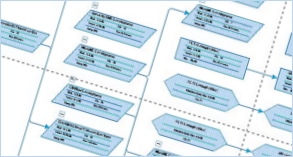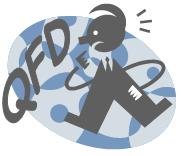Archive for the 'Quality Function Deployment' Category
January 21st, 2011 by Dr. Thomas M. Fehlmann

During the last years a tendency has been observed to position QFD more towards understanding customer’s needs than doing complex matrix mathemagics with insecure data and producing fuzzy evaluation profiles. It is more important saving (customer’s) time than understanding relationships between process controls and process response.
Customer’s needs can be analyzed by means of Thomas Saaty’s Analytic Hierarchical Process (AHP), prioritized with ratio scales, and assessed for consistency. This seems much quicker and more reliable than assessing the Voice of the Engineers, and then trying to understand how it transforms into something that meets Voice of the Customer’s requirements.
However, this opinion stands in contrast to the Six Sigma approach, used to define, measure, analyze, improve, and control (DMAIC) relationships between process controls and process responses. Such relationship mapping is called Transfer Function. For instance, a transfer function describes how to transform controls used by engineers into response expected by customers. If there are more than one response characteristics, and more than one control impacts the response, the QFD matrix is the natural choice for representing the transfer function.
Read the rest of this entry »
Category: House of Quality, Advice, DFSS, Lean Six Sigma, Quality Function Deployment, QFD |
9 Comments »
January 10th, 2009 by James Grover
 There has been much debate over which representation is the best to use when filling in the ratings for a House of Quality: symbolic notation or numeric notation. The premise behind the debate is that there is somehow a greater inherent value in using circles, filled circles, and triangles or in using 1’s, 3’s, and 9’s. In actuality, neither format is universally superior to the other. On the contrary, they both serve different purposes and are uniquely suited for working with different groups. Thus, just as it is important to tailor a speech or written argument to the needs of the intended audience, it is important to choose the notation for a QFD that is best suited for its target audience.
There has been much debate over which representation is the best to use when filling in the ratings for a House of Quality: symbolic notation or numeric notation. The premise behind the debate is that there is somehow a greater inherent value in using circles, filled circles, and triangles or in using 1’s, 3’s, and 9’s. In actuality, neither format is universally superior to the other. On the contrary, they both serve different purposes and are uniquely suited for working with different groups. Thus, just as it is important to tailor a speech or written argument to the needs of the intended audience, it is important to choose the notation for a QFD that is best suited for its target audience.
Read the rest of this entry »
Category: House of Quality, Advice, Quality Function Deployment, QFD |
1 Comment »
December 22nd, 2008 by Peter Wolfe
 I still remember the Brady Bunch episode in which Greg talked his parents into remodeling their attic into his bedroom (after a fight with Marcia over whose room it should be). From the moment I first saw that show, I dreamt of overhauling my parents’ attic. Today, many engineers are doing just that–-repurposing their attics and making better use of them. However, the attics which I am referring to are not in their homes, but rather in their Quality Function Deployment matrices (i.e. “Houses of Quality”). Although many customizations have been made to the QFD “roof”, my favorite modifications is the addition of the “dependency” concept.
I still remember the Brady Bunch episode in which Greg talked his parents into remodeling their attic into his bedroom (after a fight with Marcia over whose room it should be). From the moment I first saw that show, I dreamt of overhauling my parents’ attic. Today, many engineers are doing just that–-repurposing their attics and making better use of them. However, the attics which I am referring to are not in their homes, but rather in their Quality Function Deployment matrices (i.e. “Houses of Quality”). Although many customizations have been made to the QFD “roof”, my favorite modifications is the addition of the “dependency” concept.
Read the rest of this entry »
Category: House of Quality, Remodeling the HOQ™, Agile, Quality Function Deployment, QFD, TRIZ |
2 Comments »
August 27th, 2008 by James Grover
 Several months ago I published an article entitled “Who’s Your Daddy” which discussed why it is imperative to listen to the disparate (and sometimes contradictory) voices of different customers. Since that time, I have received several inquiries about the mechanics of exactly how one blends the voices of conflicting business, consumer, and regulatory groups into a single “VOC” for a Quality Function Deployment. The intent of this article is to answer those inquiries by giving an overview of the two primary processes for blending the requirements from these disparate groups, namely: “Percentage Translation” and “House of Quality Folding”.
Several months ago I published an article entitled “Who’s Your Daddy” which discussed why it is imperative to listen to the disparate (and sometimes contradictory) voices of different customers. Since that time, I have received several inquiries about the mechanics of exactly how one blends the voices of conflicting business, consumer, and regulatory groups into a single “VOC” for a Quality Function Deployment. The intent of this article is to answer those inquiries by giving an overview of the two primary processes for blending the requirements from these disparate groups, namely: “Percentage Translation” and “House of Quality Folding”.
Read the rest of this entry »
Category: House of Quality, Advice, Voice of the Customer, Remodeling the HOQ™, Quality Function Deployment, QFD |
1 Comment »
May 10th, 2008 by James Grover
 The Quality Function Deployment (QFD) process is probably the most effective methodology available for capturing and responding to the “voice of the customer”. Few people dispute the effectiveness of QFD, but many people express concerns about its efficiency. Although the tools of QFD are extremely valuable for prioritizing product and/or service development efforts, they can be arguably cumbersome. In fact, many management teams that implement a QFD process end up abandoning it after a few months due to the time requirements of following such a rigorous methodology. Although the time saved by reducing unnecessary course corrections far outweighs the additional overhead of implementing Quality Function Deployment, there is definitely a significant upfront time investiture associated with the process. However, there are several time saving procedures that QFD teams can utilize to significantly decrease the arduousness associated with the methodology. One particularly beneficial time saver is that of “voting blind”.
The Quality Function Deployment (QFD) process is probably the most effective methodology available for capturing and responding to the “voice of the customer”. Few people dispute the effectiveness of QFD, but many people express concerns about its efficiency. Although the tools of QFD are extremely valuable for prioritizing product and/or service development efforts, they can be arguably cumbersome. In fact, many management teams that implement a QFD process end up abandoning it after a few months due to the time requirements of following such a rigorous methodology. Although the time saved by reducing unnecessary course corrections far outweighs the additional overhead of implementing Quality Function Deployment, there is definitely a significant upfront time investiture associated with the process. However, there are several time saving procedures that QFD teams can utilize to significantly decrease the arduousness associated with the methodology. One particularly beneficial time saver is that of “voting blind”.
Read the rest of this entry »
Category: House of Quality, Advice, Voice of the Customer, Quality Function Deployment, QFD |
3 Comments »
April 29th, 2008 by Peter Wolfe
 You’ve probably heard the old adage, “If you fail to plan, then you’re planning to fail.” That sentiment is certainly echoed in the basic principles of the Quality Function Deployment (QFD) methodology. There is another old adage concerning failure that, although not quite as recognized, is just as true: “Fail to mitigate failure and you will succeed in minimizing success.” (Okay, so it isn’t really an old adage. I just made it up. However, you have to admit, it does sound rather catchy, and it does convey the underlying precept fairly well.) This maxim (regardless of how it is worded) is similarly echoed by the tenets of Quality Function Deployment.
You’ve probably heard the old adage, “If you fail to plan, then you’re planning to fail.” That sentiment is certainly echoed in the basic principles of the Quality Function Deployment (QFD) methodology. There is another old adage concerning failure that, although not quite as recognized, is just as true: “Fail to mitigate failure and you will succeed in minimizing success.” (Okay, so it isn’t really an old adage. I just made it up. However, you have to admit, it does sound rather catchy, and it does convey the underlying precept fairly well.) This maxim (regardless of how it is worded) is similarly echoed by the tenets of Quality Function Deployment.
So then, the question arises–what is the best tool for prioritizing steps to mitigate potential failures: Failure Mode and Effects Analysis (FMEA) or the House of Quality (HOQ) tool? Coming from a Quality Function Deployment enthusiast, my answer may surprise you…
Read the rest of this entry »
Category: History of QFD, House of Quality, Advice, Voice of the Customer, DFSS, Quality Function Deployment, QFD, CTQ, CTC, FMEA |
18 Comments »
March 31st, 2008 by John Livingston
 I have been asked on several occasions what industries Quality Function Deployment (QFD) is useful for. My tongue-in-cheek response to such inquiries is that “QFD is only useful for those industries that have decisions to make and customers to please”. In all seriousness, QFD is about communication and decision making, and its tools can truly be used in any industry. The House of Quality matrix, in particular, is an almost universal tool that can be used for prioritizing anything from a family budget to the complex engineering tasks of an automobile manufacturer.
I have been asked on several occasions what industries Quality Function Deployment (QFD) is useful for. My tongue-in-cheek response to such inquiries is that “QFD is only useful for those industries that have decisions to make and customers to please”. In all seriousness, QFD is about communication and decision making, and its tools can truly be used in any industry. The House of Quality matrix, in particular, is an almost universal tool that can be used for prioritizing anything from a family budget to the complex engineering tasks of an automobile manufacturer.
Read the rest of this entry »
Category: House of Quality, Voice of the Customer, Quality Function Deployment, QFD |
2 Comments »
January 5th, 2008 by James Grover

What’s in a name? While Shakespeare may have been correct in observing that “that which we call a rose by any other name would smell as sweet”, most people would not know what you were talking about if you referred to it as a “bee leaf pollen perch”.
Similarly, the name “Quality Function Deployment” gives little hint as to what the tool actually is or what purpose it serves. So why is its name so perplexing? The answer lies in two main issues…
First, “Quality Function Deployment” was originally created by two Japanese professors back in the 1960’s (Drs. Yoji Akao and Shigeru Mizuno). Thus, the process was originally given a Japanese name, which was later translated into English. The original Japanese name, “Hin-shitsu Ki-no Ten-kai”, was translated quite litterally into the name “Quality Function Deployment”. Although the name supposedly carries with it a more intuitive meaning in Japanese, it doesn’t seem to have the same readily apparent meaning in English.
Additionally, the term “QFD” is used by many people today to refer to a series of “House of Quality” matrices strung together to define customer requirements and translate them into specific product features to meet those needs. However, these prioritization matrices were only a small part of the system that Drs. Akao and Mizuno originally created. (See “What is the House of Quality? Why it isn’t a QFD?” at qfdi.org for more information on this topic.) Thus, the application of the term “QFD” has changed over the course of the past 30+ years as well. Even though much was lost in translation from its Japanese name, “Quality Function Deployment” was a much more apropos name for the system of processes originally created by Akao and Mizumo than it is for the derivative tool that it has come to refer to today.
Category: History of QFD, House of Quality, Quality Function Deployment, QFD |
8 Comments »
December 15th, 2007 by Peter Wolfe
 I was recently reviewing a QFD that was created by a group of software developers. They had opted to omit several traditional columns, rows and/or matrices, and had added some new ones. On their final House of Quality they had added a “status” column. Many of the top requirements on this HOQ (the list was sorted by calculated importance) had status values of “Prioritized” or “Completed”. However, I noticed that several of the highest ranked requirements had been skipped and had no status at all. I assumed that these items had no status because they had only recently been added to the QFD. However, I soon learned that my assumption was wrong—these items had been skipped because there simply wasn’t enough time left before the upcoming version release to try to bite off such complex or difficult features.
I was recently reviewing a QFD that was created by a group of software developers. They had opted to omit several traditional columns, rows and/or matrices, and had added some new ones. On their final House of Quality they had added a “status” column. Many of the top requirements on this HOQ (the list was sorted by calculated importance) had status values of “Prioritized” or “Completed”. However, I noticed that several of the highest ranked requirements had been skipped and had no status at all. I assumed that these items had no status because they had only recently been added to the QFD. However, I soon learned that my assumption was wrong—these items had been skipped because there simply wasn’t enough time left before the upcoming version release to try to bite off such complex or difficult features.
I asked the team how they knew that a given feature was too complex or time-consuming to complete before a scheduled deadline. I was informed that team members were assigned to do some preliminary analysis on top features in order to estimate how difficult it would be to complete them. When I then asked where they logged this information, I was informed that they “just remembered it”. I then asked how they communicated this information upstream to the business stake holders and received some blank stares. When I asked why they had removed the “difficulty” row from their QFD, I was met with questioning glances and the response, “difficulty row?”
Read the rest of this entry »
Category: Remodeling the HOQ™, Agile, Quality Function Deployment, QFD |
1 Comment »
November 21st, 2007 by John Livingston
 Imagine for a moment that you are the president of a successful software development company. Your company is doing reasonably well from a sales perspective, but you have been dealing with some sizable challenges in terms of your development team hitting their scheduled release dates on time. (The past 2 releases have been late by more than six months a piece.) Then one day your development manager comes into your office droning on about the success of something called “Agile” development methodologies. He goes on to tell you that he knows how to eliminate the slippages that he and his team have experienced in relation to your two year development plan: simply do away with the two year development plan. Needless to say, the conversation would probably not go well. However, there is a sweetener that can assist executive management in swallowing the sometimes bitter pill of “Agile” development—and that sweetener bears the name “QFD“.
Imagine for a moment that you are the president of a successful software development company. Your company is doing reasonably well from a sales perspective, but you have been dealing with some sizable challenges in terms of your development team hitting their scheduled release dates on time. (The past 2 releases have been late by more than six months a piece.) Then one day your development manager comes into your office droning on about the success of something called “Agile” development methodologies. He goes on to tell you that he knows how to eliminate the slippages that he and his team have experienced in relation to your two year development plan: simply do away with the two year development plan. Needless to say, the conversation would probably not go well. However, there is a sweetener that can assist executive management in swallowing the sometimes bitter pill of “Agile” development—and that sweetener bears the name “QFD“.
Read the rest of this entry »
Category: Voice of the Customer, Agile, Quality Function Deployment, QFD, Software |
2 Comments »
October 9th, 2007 by James Grover
 A comment was recently submitted to QFD Online regarding the limits that should be imposed on the number of requirements for any given House of Quality. The basic premise of the comment was that the number of requirements should be limited in order to keep the HOQ “maintainable”. While the core principle was accurate (i.e. that it requires care and attention when crafting a QFD in order to make sure that it can be maintained long-term), the idea that there is a one-size-fits-all limit that can be used is misguided. Luckily, however, there are processes and procedures that can be applied on a case-by-case basis to ensure maintainable requirement lists.
A comment was recently submitted to QFD Online regarding the limits that should be imposed on the number of requirements for any given House of Quality. The basic premise of the comment was that the number of requirements should be limited in order to keep the HOQ “maintainable”. While the core principle was accurate (i.e. that it requires care and attention when crafting a QFD in order to make sure that it can be maintained long-term), the idea that there is a one-size-fits-all limit that can be used is misguided. Luckily, however, there are processes and procedures that can be applied on a case-by-case basis to ensure maintainable requirement lists.
Read the rest of this entry »
Category: House of Quality, Advice, Agile, Quality Function Deployment, QFD |
2 Comments »
September 30th, 2007 by Peter Wolfe
 Have you ever watched a team of engineers modifying their secondary requirements (a.k.a. the “quality characteristics hierarchy” or “hows”) on a House of Quality spreadsheet? They remind me of a group of hillbillies staring at a piece of modern art—their heads are usually cocked to the side with grimaced looks on their faces. (It’s quite entertaining actually.) Considering that in a spreadsheet environment secondary requirements are generally edited far more than primary requirements (the primary requirements list or “demanded quality hierarchy” is usually pulled automatically from other Houses of Quality in the QFD), have you ever wondered why it is that the secondary requirements are the ones that are flipped on their sides and run across the top of the HOQ?
Have you ever watched a team of engineers modifying their secondary requirements (a.k.a. the “quality characteristics hierarchy” or “hows”) on a House of Quality spreadsheet? They remind me of a group of hillbillies staring at a piece of modern art—their heads are usually cocked to the side with grimaced looks on their faces. (It’s quite entertaining actually.) Considering that in a spreadsheet environment secondary requirements are generally edited far more than primary requirements (the primary requirements list or “demanded quality hierarchy” is usually pulled automatically from other Houses of Quality in the QFD), have you ever wondered why it is that the secondary requirements are the ones that are flipped on their sides and run across the top of the HOQ?
Read the rest of this entry »
Category: House of Quality, Advice, Remodeling the HOQ™, Quality Function Deployment, QFD |
2 Comments »
August 23rd, 2007 by Peter Wolfe
 In 1979, a PBS station in Boston called “WGBH” aired a one-time, 13-part series entitled “This Old House”. Since that time, the program has grown to become one of PBS’s most popular programs, has generated spin-offs, produced a popular magazine, spawned a for-profit website, and even inspired sitcoms.[1] And why has this program been so successful? In my opinion, it’s because people have an inherent love for taking something great, stripping away its faults, and putting it to new found use. That is the same explanation that I use when people ask me about Quality Function Deployment’s resurgence in popularity during recent years. In short, when people ask me why QFD has experienced so much growth in adoption, my answer is simply: “This Old House…of Quality”.
In 1979, a PBS station in Boston called “WGBH” aired a one-time, 13-part series entitled “This Old House”. Since that time, the program has grown to become one of PBS’s most popular programs, has generated spin-offs, produced a popular magazine, spawned a for-profit website, and even inspired sitcoms.[1] And why has this program been so successful? In my opinion, it’s because people have an inherent love for taking something great, stripping away its faults, and putting it to new found use. That is the same explanation that I use when people ask me about Quality Function Deployment’s resurgence in popularity during recent years. In short, when people ask me why QFD has experienced so much growth in adoption, my answer is simply: “This Old House…of Quality”.
Read the rest of this entry »
Category: House of Quality, Remodeling the HOQ™, DFSS, Lean Six Sigma, Quality Function Deployment, QFD |
1 Comment »
July 19th, 2007 by James Grover
 Most people believe that the first step in creating a successful QFD is to identify the list of customer requirements. Although documenting customer requirements is key to ensuring that the “voice of the customer” is heard, there is actually an even more crucial first step. The very first task to complete when creating a Quality Function Deployment is to identify exactly who your “daddy” (i.e. customer) really is, and that task isn’t as easy as you might think.
Most people believe that the first step in creating a successful QFD is to identify the list of customer requirements. Although documenting customer requirements is key to ensuring that the “voice of the customer” is heard, there is actually an even more crucial first step. The very first task to complete when creating a Quality Function Deployment is to identify exactly who your “daddy” (i.e. customer) really is, and that task isn’t as easy as you might think.
Numerous QFDs fail (i.e. cease to be used or to be useful) because too many features are added to the relevant product or service in a manner that bypasses the QFD altogether. These assignments are made in a manner that circumvents the system in order to address “urgent” requirements. Unfortunately, as soon as a window is opened for non-customers to push “urgent” matters to the front of the queue, they stop using methodical processes for prioritization altogether. Soon, every pet project or feature gets identified as “urgent” or “imperative”, and the QFD falls to the wayside with the voice of the customer close behind.
This may seem like an easy problem to fix—all that needs to be done is to make sure that these “urgent” items get added to the QFD like every other feature or requirement. If needed, these items can be evaluated and rated before other requirements, but they won’t be worked on until they merit attention. The problem is that many of these urgent items would never warrant attention, according to the QFD, because the wrong customer was identified in the first place.
Read the rest of this entry »
Category: Advice, Voice of the Customer, Quality Function Deployment, QFD |
4 Comments »

 There has been much debate over which representation is the best to use when filling in the ratings for a House of Quality: symbolic notation or numeric notation. The premise behind the debate is that there is somehow a greater inherent value in using circles, filled circles, and triangles or in using 1’s, 3’s, and 9’s. In actuality, neither format is universally superior to the other. On the contrary, they both serve different purposes and are uniquely suited for working with different groups. Thus, just as it is important to tailor a speech or written argument to the needs of the intended audience, it is important to choose the notation for a QFD that is best suited for its target audience.
There has been much debate over which representation is the best to use when filling in the ratings for a House of Quality: symbolic notation or numeric notation. The premise behind the debate is that there is somehow a greater inherent value in using circles, filled circles, and triangles or in using 1’s, 3’s, and 9’s. In actuality, neither format is universally superior to the other. On the contrary, they both serve different purposes and are uniquely suited for working with different groups. Thus, just as it is important to tailor a speech or written argument to the needs of the intended audience, it is important to choose the notation for a QFD that is best suited for its target audience.  I still remember the Brady Bunch episode in which Greg talked his parents into remodeling their attic into his bedroom (after a fight with Marcia over whose room it should be). From the moment I first saw that show, I dreamt of overhauling my parents’ attic. Today, many engineers are doing just that–-repurposing their attics and making better use of them. However, the attics which I am referring to are not in their homes, but rather in their Quality Function Deployment matrices (i.e. “Houses of Quality”). Although many customizations have been made to the QFD “roof”, my favorite modifications is the addition of the “dependency” concept.
I still remember the Brady Bunch episode in which Greg talked his parents into remodeling their attic into his bedroom (after a fight with Marcia over whose room it should be). From the moment I first saw that show, I dreamt of overhauling my parents’ attic. Today, many engineers are doing just that–-repurposing their attics and making better use of them. However, the attics which I am referring to are not in their homes, but rather in their Quality Function Deployment matrices (i.e. “Houses of Quality”). Although many customizations have been made to the QFD “roof”, my favorite modifications is the addition of the “dependency” concept.  Several months ago I published an article entitled “
Several months ago I published an article entitled “ The Quality Function Deployment (QFD) process is probably the most effective methodology available for capturing and responding to the “voice of the customer”. Few people dispute the effectiveness of QFD, but many people express concerns about its efficiency. Although the tools of QFD are extremely valuable for prioritizing product and/or service development efforts, they can be arguably cumbersome. In fact, many management teams that implement a QFD process end up abandoning it after a few months due to the time requirements of following such a rigorous methodology. Although the time saved by reducing unnecessary course corrections far outweighs the additional overhead of implementing Quality Function Deployment, there is definitely a significant upfront time investiture associated with the process. However, there are several time saving procedures that QFD teams can utilize to significantly decrease the arduousness associated with the methodology. One particularly beneficial time saver is that of “voting blind”.
The Quality Function Deployment (QFD) process is probably the most effective methodology available for capturing and responding to the “voice of the customer”. Few people dispute the effectiveness of QFD, but many people express concerns about its efficiency. Although the tools of QFD are extremely valuable for prioritizing product and/or service development efforts, they can be arguably cumbersome. In fact, many management teams that implement a QFD process end up abandoning it after a few months due to the time requirements of following such a rigorous methodology. Although the time saved by reducing unnecessary course corrections far outweighs the additional overhead of implementing Quality Function Deployment, there is definitely a significant upfront time investiture associated with the process. However, there are several time saving procedures that QFD teams can utilize to significantly decrease the arduousness associated with the methodology. One particularly beneficial time saver is that of “voting blind”.  You’ve probably heard the old adage, “If you fail to plan, then you’re planning to fail.” That sentiment is certainly echoed in the basic principles of the Quality Function Deployment (QFD) methodology. There is another old adage concerning failure that, although not quite as recognized, is just as true: “Fail to mitigate failure and you will succeed in minimizing success.” (Okay, so it isn’t really an old adage. I just made it up. However, you have to admit, it does sound rather catchy, and it does convey the underlying precept fairly well.) This maxim (regardless of how it is worded) is similarly echoed by the tenets of Quality Function Deployment.
You’ve probably heard the old adage, “If you fail to plan, then you’re planning to fail.” That sentiment is certainly echoed in the basic principles of the Quality Function Deployment (QFD) methodology. There is another old adage concerning failure that, although not quite as recognized, is just as true: “Fail to mitigate failure and you will succeed in minimizing success.” (Okay, so it isn’t really an old adage. I just made it up. However, you have to admit, it does sound rather catchy, and it does convey the underlying precept fairly well.) This maxim (regardless of how it is worded) is similarly echoed by the tenets of Quality Function Deployment. I have been asked on several occasions what industries Quality Function Deployment (QFD) is useful for. My tongue-in-cheek response to such inquiries is that “QFD is only useful for those industries that have decisions to make and customers to please”. In all seriousness, QFD is about communication and decision making, and its tools can truly be used in any industry. The House of Quality matrix, in particular, is an almost universal tool that can be used for prioritizing anything from a family budget to the complex engineering tasks of an automobile manufacturer.
I have been asked on several occasions what industries Quality Function Deployment (QFD) is useful for. My tongue-in-cheek response to such inquiries is that “QFD is only useful for those industries that have decisions to make and customers to please”. In all seriousness, QFD is about communication and decision making, and its tools can truly be used in any industry. The House of Quality matrix, in particular, is an almost universal tool that can be used for prioritizing anything from a family budget to the complex engineering tasks of an automobile manufacturer. 
 I was recently reviewing a QFD that was created by a group of software developers. They had opted to omit several traditional columns, rows and/or matrices, and had added some new ones. On their final House of Quality they had added a “status” column. Many of the top requirements on this HOQ (the list was sorted by calculated importance) had status values of “Prioritized” or “Completed”. However, I noticed that several of the highest ranked requirements had been skipped and had no status at all. I assumed that these items had no status because they had only recently been added to the QFD. However, I soon learned that my assumption was wrong—these items had been skipped because there simply wasn’t enough time left before the upcoming version release to try to bite off such complex or difficult features.
I was recently reviewing a QFD that was created by a group of software developers. They had opted to omit several traditional columns, rows and/or matrices, and had added some new ones. On their final House of Quality they had added a “status” column. Many of the top requirements on this HOQ (the list was sorted by calculated importance) had status values of “Prioritized” or “Completed”. However, I noticed that several of the highest ranked requirements had been skipped and had no status at all. I assumed that these items had no status because they had only recently been added to the QFD. However, I soon learned that my assumption was wrong—these items had been skipped because there simply wasn’t enough time left before the upcoming version release to try to bite off such complex or difficult features.  Imagine for a moment that you are the president of a successful software development company. Your company is doing reasonably well from a sales perspective, but you have been dealing with some sizable challenges in terms of your development team hitting their scheduled release dates on time. (The past 2 releases have been late by more than six months a piece.) Then one day your development manager comes into your office droning on about the success of something called “Agile” development methodologies. He goes on to tell you that he knows how to eliminate the slippages that he and his team have experienced in relation to your two year development plan: simply do away with the two year development plan. Needless to say, the conversation would probably not go well. However, there is a sweetener that can assist executive management in swallowing the sometimes bitter pill of “Agile” development—and that sweetener bears the name “QFD“.
Imagine for a moment that you are the president of a successful software development company. Your company is doing reasonably well from a sales perspective, but you have been dealing with some sizable challenges in terms of your development team hitting their scheduled release dates on time. (The past 2 releases have been late by more than six months a piece.) Then one day your development manager comes into your office droning on about the success of something called “Agile” development methodologies. He goes on to tell you that he knows how to eliminate the slippages that he and his team have experienced in relation to your two year development plan: simply do away with the two year development plan. Needless to say, the conversation would probably not go well. However, there is a sweetener that can assist executive management in swallowing the sometimes bitter pill of “Agile” development—and that sweetener bears the name “QFD“.  A comment was recently submitted to QFD Online regarding the limits that should be imposed on the number of requirements for any given House of Quality. The basic premise of the comment was that the number of requirements should be limited in order to keep the HOQ “maintainable”. While the core principle was accurate (i.e. that it requires care and attention when crafting a QFD in order to make sure that it can be maintained long-term), the idea that there is a one-size-fits-all limit that can be used is misguided. Luckily, however, there are processes and procedures that can be applied on a case-by-case basis to ensure maintainable requirement lists.
A comment was recently submitted to QFD Online regarding the limits that should be imposed on the number of requirements for any given House of Quality. The basic premise of the comment was that the number of requirements should be limited in order to keep the HOQ “maintainable”. While the core principle was accurate (i.e. that it requires care and attention when crafting a QFD in order to make sure that it can be maintained long-term), the idea that there is a one-size-fits-all limit that can be used is misguided. Luckily, however, there are processes and procedures that can be applied on a case-by-case basis to ensure maintainable requirement lists.  Have you ever watched a team of engineers modifying their secondary requirements (a.k.a. the “quality characteristics hierarchy” or “hows”) on a House of Quality spreadsheet? They remind me of a group of hillbillies staring at a piece of modern art—their heads are usually cocked to the side with grimaced looks on their faces. (It’s quite entertaining actually.) Considering that in a spreadsheet environment secondary requirements are generally edited far more than primary requirements (the primary requirements list or “demanded quality hierarchy” is usually pulled automatically from other Houses of Quality in the QFD), have you ever wondered why it is that the secondary requirements are the ones that are flipped on their sides and run across the top of the HOQ?
Have you ever watched a team of engineers modifying their secondary requirements (a.k.a. the “quality characteristics hierarchy” or “hows”) on a House of Quality spreadsheet? They remind me of a group of hillbillies staring at a piece of modern art—their heads are usually cocked to the side with grimaced looks on their faces. (It’s quite entertaining actually.) Considering that in a spreadsheet environment secondary requirements are generally edited far more than primary requirements (the primary requirements list or “demanded quality hierarchy” is usually pulled automatically from other Houses of Quality in the QFD), have you ever wondered why it is that the secondary requirements are the ones that are flipped on their sides and run across the top of the HOQ?  In 1979, a PBS station in Boston called “WGBH” aired a one-time, 13-part series entitled “This Old House”. Since that time, the program has grown to become one of PBS’s most popular programs, has generated spin-offs, produced a popular magazine, spawned a for-profit website, and even inspired sitcoms.[
In 1979, a PBS station in Boston called “WGBH” aired a one-time, 13-part series entitled “This Old House”. Since that time, the program has grown to become one of PBS’s most popular programs, has generated spin-offs, produced a popular magazine, spawned a for-profit website, and even inspired sitcoms.[ Most people believe that the first step in creating a successful QFD is to identify the list of customer requirements. Although documenting customer requirements is key to ensuring that the “voice of the customer” is heard, there is actually an even more crucial first step. The very first task to complete when creating a Quality Function Deployment is to identify exactly who your “daddy” (i.e. customer) really is, and that task isn’t as easy as you might think.
Most people believe that the first step in creating a successful QFD is to identify the list of customer requirements. Although documenting customer requirements is key to ensuring that the “voice of the customer” is heard, there is actually an even more crucial first step. The very first task to complete when creating a Quality Function Deployment is to identify exactly who your “daddy” (i.e. customer) really is, and that task isn’t as easy as you might think.

